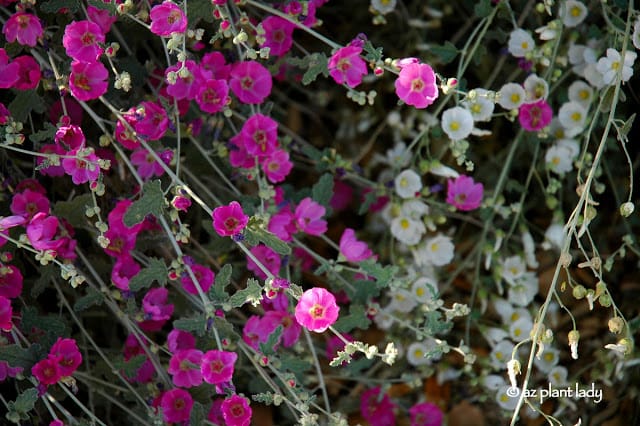Key Takeaways
Rose Mallow and Globemallow are not toxic to dogs, making them safe for your pets.
Keep an eye out for symptoms like vomiting or lethargy if your dog ingests any plant.
Mallow plants are also safe for cats, posing no toxic risks.
You can grow Mallow plants in pots by choosing the right pot and soil, and ensuring proper watering and drainage.
Most Mallow varieties will come back every year, especially if they are perennials and cared for properly.
Is Rose Mallow or Globemallow Toxic to Dogs?
When it comes to our furry friends, safety is always a top priority. Fortunately, both Rose Mallow and Globemallow are not toxic to dogs. This means you can enjoy these beautiful plants in your garden without worrying about your dog getting sick if they decide to take a nibble.
“Globe Mallow …” from www.azplantlady.com and used with no modifications.
Identifying Toxicity in Plants
Identifying whether a plant is toxic or not can be challenging. Toxic plants often contain harmful compounds that can cause various symptoms in pets, such as vomiting, diarrhea, and lethargy. It’s essential to know which plants are safe and which ones to avoid.
Effects on Dogs
Even though Rose Mallow and Globemallow are safe for dogs, it’s still crucial to monitor your pet. Dogs are naturally curious and might chew on plants out of boredom or curiosity. While these plants are non-toxic, consuming large quantities of any plant material can still cause mild digestive upset.
Symptoms of Plant Poisoning in Dogs
If your dog ingests a toxic plant, you might notice symptoms like:
Vomiting
Diarrhea
Lethargy
Lack of appetite
If you observe any of these symptoms, it’s essential to consult your vet immediately. Quick action can prevent more severe health issues.
“If your dog decides that Swamp Rose-Mallow is the snack of the day, vigilance is key. Symptoms like vomiting or diarrhea are your first hints of trouble. Lethargy or a sudden lack of appetite are also signs to watch for.” – Kiersten Rankel
Safety of Mallow for Cats
Cats, like dogs, are curious creatures and might be tempted to chew on plants. The good news is that Mallow plants, including Rose Mallow and Globemallow, are safe for cats as well. This means you can have these plants around your home without worrying about your feline friends.
Non-Toxic Nature of Mallow for Cats
Mallow plants do not contain any toxic compounds that could harm cats. This makes them an excellent choice for households with multiple pets. However, as with dogs, it’s always best to monitor your cat and ensure they don’t consume large amounts of any plant.
Safe Plant Alternatives for Cat Owners
Rosemary
Bromeliads
Oat or wheat grasses
Roses
Coreopsis
Coral bells
Phlox
These plants are also non-toxic and can add beauty to your home without posing any risks to your pets. For example, cat grass care is simple and can be a great addition to your pet-friendly garden.
Growing Mallow in Pots
Growing Mallow plants in pots is a great way to enjoy their beauty while keeping them accessible and manageable. Here’s how you can do it:
Choosing the Right Pot
Selecting the right pot is crucial for the healthy growth of Mallow plants. Choose a pot that is large enough to accommodate the plant’s root system and has drainage holes to prevent waterlogging.
Soil Requirements
Mallow plants thrive in well-draining soil. A good potting mix that includes perlite or sand can help improve drainage and prevent root rot.
Watering and Drainage Tips
Proper watering is essential for Mallow plants. Overwatering can lead to root rot, while underwatering can cause the plant to wilt. Water the plant when the top inch of soil feels dry to the touch.
“Elevated planters can be a stylish and functional way to keep Swamp Rose-Mallow and other plants out of your dog’s reach. Consider using physical barriers like decorative fencing or raised beds to delineate play areas from green zones.” – Kiersten Rankel
Will Mallow Plants Come Back Every Year?
One of the most appealing aspects of Mallow plants is their potential to return year after year. This characteristic can make them a favorite among gardeners who appreciate perennials for their longevity and ease of care. However, whether a Mallow plant will come back every year depends on several factors, including the variety and the local climate.
Perennial vs. Annual Varieties
Mallow plants come in both perennial and annual varieties. Perennial Mallow plants, such as the Swamp Rose-Mallow, will typically come back every year if they are properly cared for. On the other hand, annual varieties complete their life cycle in one growing season and will not return the following year unless you plant new seeds.
Climate Considerations
Climate plays a significant role in the survival of Mallow plants. In warmer climates, perennial varieties can thrive and return year after year. However, in colder regions, these plants may struggle to survive harsh winters. Here are some climate considerations to keep in mind:
In USDA hardiness zones 5-9, most perennial Mallow varieties can survive winter and regrow in spring.
In zones 4 and below, you may need to provide additional winter protection or consider growing Mallow as an annual.
Extreme heat can also stress Mallow plants, so ensure they have some shade during the hottest parts of the day.
By understanding your local climate and choosing the appropriate Mallow variety, you can increase the chances of your plants returning each year.
Winter Care for Mallow Plants
Proper winter care is crucial for ensuring that your perennial Mallow plants come back in the spring. Here are some tips to help your Mallow plants survive the winter months: For pet owners, it’s also important to consider pet-friendly plants that can thrive alongside your Mallow plants.
Mulch: Apply a layer of mulch around the base of the plant to help insulate the roots and retain moisture.
Pruning: Cut back the stems to a few inches above the ground after the first frost to prevent disease and encourage new growth.
Watering: Water the plant thoroughly before the ground freezes to ensure it has enough moisture to survive the winter.
Protection: In colder regions, consider covering the plant with burlap or a frost cloth to protect it from extreme temperatures.
Following these winter care tips can help your Mallow plants return healthy and strong each year.
Care Tips for Top Pet-Friendly Mallow Varieties
Now that we’ve established that Mallow plants are safe for pets and can potentially return every year, let’s dive into specific care tips for the top pet-friendly Mallow varieties. These tips will help you keep your Mallow plants thriving while ensuring they remain safe for your furry friends. For more details on different varieties, you can check out Better Homes & Gardens.
Swamp Rose-Mallow
The Swamp Rose-Mallow (Hibiscus moscheutos) is a stunning perennial that produces large, showy flowers. It thrives in wet, marshy conditions, making it an excellent choice for gardens with poor drainage. Here are some care tips for Swamp Rose-Mallow:
Soil: Prefers moist, well-draining soil rich in organic matter.
Light: Requires full sun to partial shade for optimal growth.
Watering: Keep the soil consistently moist, especially during dry periods.
Fertilization: Apply a balanced, slow-release fertilizer in early spring to promote healthy growth.
Pruning: Cut back the stems in late fall to encourage new growth in spring.
Globemallow
Globemallow (Sphaeralcea spp.) is a hardy perennial that produces vibrant orange or pink flowers. It is drought-tolerant and can thrive in various soil types, making it a versatile addition to any garden. Here are some care tips for Globemallow:
Soil: Prefers well-draining soil but can tolerate poor soil conditions.
Light: Requires full sun for optimal flowering.
Watering: Water sparingly, as Globemallow is drought-tolerant and can suffer from overwatering.
Fertilization: Minimal fertilization is needed; a light application of compost in spring can suffice.
Pruning: Prune dead or damaged stems in early spring to encourage new growth.
Common Mallow
Common Mallow (Malva sylvestris) is a versatile plant known for its beautiful purple flowers and medicinal properties. It is easy to grow and can thrive in various conditions. Here are some care tips for Common Mallow:
Soil: Prefers well-draining soil but can tolerate a range of soil types.
Light: Requires full sun to partial shade for optimal growth.
Watering: Water regularly, allowing the soil to dry out slightly between waterings.
Fertilization: Apply a balanced fertilizer in spring to promote healthy growth.
Pruning: Cut back the stems after flowering to encourage new blooms.
Light and Temperature Requirements
Mallow plants generally prefer full sun to partial shade, depending on the variety. Ensuring they receive adequate sunlight will promote healthy growth and vibrant blooms. Additionally, most Mallow plants can tolerate a range of temperatures, but extreme heat or cold can stress the plants. Providing some shade during the hottest parts of the day and protecting them from frost can help maintain their health.
Fertilization and Pruning Techniques
Proper fertilization and pruning are essential for maintaining the health and appearance of your Mallow plants. Here are some tips:
Fertilization: Use a balanced, slow-release fertilizer in early spring to provide essential nutrients for growth. Avoid over-fertilizing, as this can lead to excessive foliage growth at the expense of flowers.
Pruning: Regularly prune dead or damaged stems to encourage new growth and maintain the plant’s shape. For perennial varieties, cut back the stems in late fall to prepare the plant for winter dormancy.
Mallow in Sensory Garden for Pets
Creating a sensory garden for pets can be a wonderful way to enrich their environment. Mallow plants, with their vibrant colors and textures, can play a significant role in such a garden. Here’s how to integrate them effectively.
Benefits of a Sensory Garden for Pets
Sensory gardens provide a stimulating environment for pets, engaging their senses and encouraging natural behaviors. These gardens can reduce stress, promote physical activity, and provide mental stimulation. For pets with limited outdoor access, a sensory garden can be particularly beneficial.
Designing a Pet-Friendly Sensory Garden
When designing a sensory garden for pets, consider the following elements:
Variety of Plants: Include a mix of textures, colors, and scents to engage your pet’s senses.
Safe Plants: Ensure all plants are non-toxic to avoid any health risks.
Interactive Elements: Add features like tunnels, water fountains, and digging areas to encourage play and exploration.
Integrating Mallow Plants Effectively
Mallow plants can be a beautiful and safe addition to your sensory garden. Place them in areas where your pets can easily see and smell them. Consider planting them in clusters to create visual interest and provide a lush, colorful backdrop. For more ideas, check out these favorite plants for rabbit gardens.
Maintaining the Garden
Regular maintenance is crucial for keeping your sensory garden safe and enjoyable for your pets. Here are some tips:
Regular Inspections: Check for any signs of plant disease or pests and address them promptly.
Safe Fertilizers: Use pet-safe fertilizers to avoid any potential toxic exposure.
Clean Water Features: Ensure water fountains and other water features are clean and free of algae.
Light and Temperature Requirements
Mallow plants generally prefer full sun to partial shade, depending on the variety. Ensuring they receive adequate sunlight will promote healthy growth and vibrant blooms. Additionally, most Mallow plants can tolerate a range of temperatures, but extreme heat or cold can stress the plants. Providing some shade during the hottest parts of the day and protecting them from frost can help maintain their health.
Fertilization and Pruning Techniques
Proper fertilization and pruning are essential for maintaining the health and appearance of your Mallow plants. Here are some tips:
Fertilization: Use a balanced, slow-release fertilizer in early spring to provide essential nutrients for growth. Avoid over-fertilizing, as this can lead to excessive foliage growth at the expense of flowers.
Pruning: Regularly prune dead or damaged stems to encourage new growth and maintain the plant’s shape. For perennial varieties, cut back the stems in late fall to prepare the plant for winter dormancy.
Frequently Asked Questions (FAQ)
Can dogs safely be around mallow plants?
Yes, dogs can safely be around Mallow plants. Both Rose Mallow and Globemallow are non-toxic to dogs, making them safe for your furry friends. For more information on pet-safe plants, you can explore other options.
What signs should I look for if my pet ingests a toxic plant?
If your pet ingests a toxic plant, watch for symptoms such as vomiting, diarrhea, lethargy, and lack of appetite. If you notice any of these signs, contact your veterinarian immediately.
Which mallow varieties are best for indoor pots?
Common Mallow (Malva sylvestris) and Swamp Rose-Mallow (Hibiscus moscheutos) are excellent choices for indoor pots. Ensure they have enough light and proper watering to thrive indoors.






